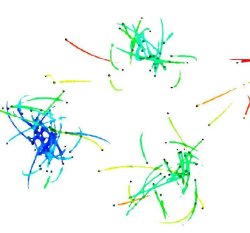Chaotic Itinerancy (2000)
An interactive reversible simulation of a mini universe with reset und return option.by Hans H. Diebner and Sven Sahle
 |
|
H.H.Diebner and S.Sahle: cluster formation in Chaotic Itinerancy
in the time series representation mode. Screenshot, 2000. |

H.H.Diebner and S.Sahle: Cluster formation in Chaotic Itinerancy in the phase space representation mode. Screenshot, 2000. |
Konishi and Kaneko showed that also in classical physics mainly developed by Isaac Newton a "chaotic itinerancy" can be observed (see below). Newtonian systems, as a matter of principle, cannot form chaotic attractors. The fact that our Universe is becoming and disintegration - in a reversed argumentation - strongly indicates that the basic equations of motion introduced by Newton are valid. Newtons classical physics is impressively consistent and obeys an optimization principle, the principle of least action, which has been introduced by Leibniz:
"Our world is the best of all possible worlds."Sometimes it is argued that within Newtons classical physics an arrow of time cannot be fixed. The disintegration, aging and death seemingly require time's arrow.
However, if time's arrow indeed would exist, then infinitely stable structures would be generic. This raises the question why such stable structures are never observed (whether the electron is an exception is still controversially discussed). Aim of the presented simulation is to stimulate deliberations whether our perception of time's arrow is the consequence of the fact that we are an intrinsic part, i.e. a temporarily stable substructure of the Universe. For a priviledged demiurge of the simulated Universe the contradictions vanish.
Exhibitions:
- ZKM-Medienmuseum, Karlsruhe, Germany 2000.
- Old and New in reversible Universes (by Hans H. Diebner, Sven Sahle and Peter Weibel, in German): A physics-didactic installation based on the "Chaotic Itinerancy" idea. Shown within the scope of the exhibition "Auge - Experiment" in the "Kärntner Landesgalerie", Klagenfurt, Austria (2000). Confer: Arnulf Rohsmann (ed.), "Auge - Experiment", Kärntner Landesgalerie, Klagenfurt 2000.